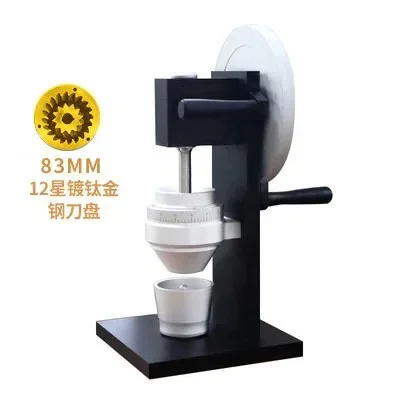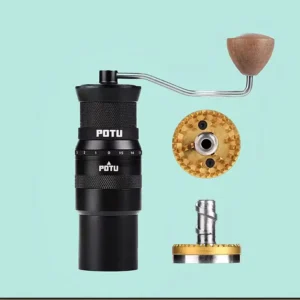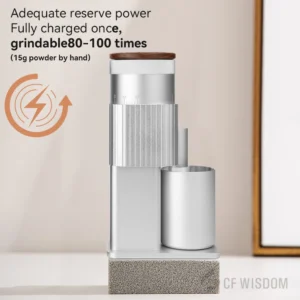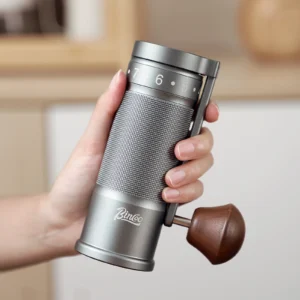Understanding the Impact of Burr Size on Coffee Grinding
Yes, burr size does affect coffee grind quality—but it’s not as simple as “bigger is always better.” When we talk about burr size in coffee grinders, we’re referring to the diameter measurement in millimeters of the grinding surfaces that crush your coffee beans. Typical burr sizes range from 38mm in entry-level grinders to 83mm in commercial-grade equipment.
Burr size impacts three key areas of your coffee grinding experience:
- Grind consistency: Larger burrs generally produce more uniform coffee particles
- Heat generation: Bigger burrs typically generate less heat during grinding
- Grinding speed: Larger diameter burrs can process coffee beans faster
Understanding these factors is crucial because they directly affect how well flavors extract from your coffee grounds. The more consistent your grind, the more evenly water interacts with coffee particles, resulting in better flavor balance.
The relationship between burr size and grind quality isn’t strictly linear—other factors like burr material, design, and alignment play important roles too. Mastering espresso precision grind settings requires understanding these nuances, as they form the foundation for proper extraction.
Professional coffee grinders typically feature larger burrs than consumer models, but this doesn’t mean home brewers can’t achieve excellent results with moderately-sized burrs. The impact of burr diameter on coffee grind is significant but must be considered alongside other grinder characteristics.
The Science of Burr Size and Grind Consistency
Particle size distribution (PSD) refers to the range of particle sizes in your ground coffee. A narrow PSD means most particles are very close to the target size—this is what we want for even extraction. A wide PSD means you have many particles that are either too small (“fines”) or too large (“boulders”).
Larger burrs can contribute to more uniform particle size in several ways:
Greater Cutting Surface Area
Larger burrs have more surface area where the cutting edges can interact with coffee beans. This increased surface area allows for:
- More cutting points to process coffee beans
- Less pressure required per cutting point
- More gradual breaking down of beans as they move through the burr set
Reduced Fines Production
“Fines” are tiny coffee particles that extract very quickly and can lead to bitter flavors. Larger burrs often produce fewer fines because:
- They can operate at lower RPMs while maintaining throughput
- They create less friction and crushing pressure
- The geometry allows for more precise cutting rather than crushing
When grinding with quality flat burr hand grinders, you can observe the difference in particle consistency with the naked eye—grounds appear more uniform with fewer dusty particles.
Research consistently shows that particle uniformity directly correlates with extraction quality. When your grounds are uniform, water extracts flavor compounds at roughly the same rate from all particles. With inconsistent grounds, smaller particles over-extract (causing bitterness) while larger ones under-extract (causing sourness)—resulting in coffee that’s simultaneously bitter and sour.
Heat Generation and Thermal Stability in Grinding
Coffee grinding creates friction, and friction generates heat—an enemy of coffee flavor. Excessive heat during grinding can:
- Cause volatile aromatic compounds to evaporate prematurely
- Accelerate oxidation of coffee oils
- Create “baked” or flat flavors in the final cup
- Reduce the perceived brightness and complexity of coffee
Larger burrs offer significant advantages when it comes to heat management:
- Greater thermal mass absorbs and dissipates heat more effectively
- Lower RPM requirements for the same throughput means less friction
- Faster grinding time reduces the duration beans are exposed to heat
When coffee particles exceed approximately 140°F (60°C) during grinding, flavor degradation begins to occur. Small burrs spinning at high speeds can easily surpass this threshold, especially during longer grinding sessions. The effects of burr heat on coffee grounds can be quite noticeable in the cup, particularly with lighter roasts where delicate floral and fruit notes are easily diminished.
Heat-affected coffee often tastes noticeably flatter, with reduced acidity and a dull, sometimes cardboard-like flavor profile. By minimizing heat buildup during grinding, larger burrs help preserve the full flavor potential of your coffee beans.
Grinding Speed and Efficiency: The Size Advantage
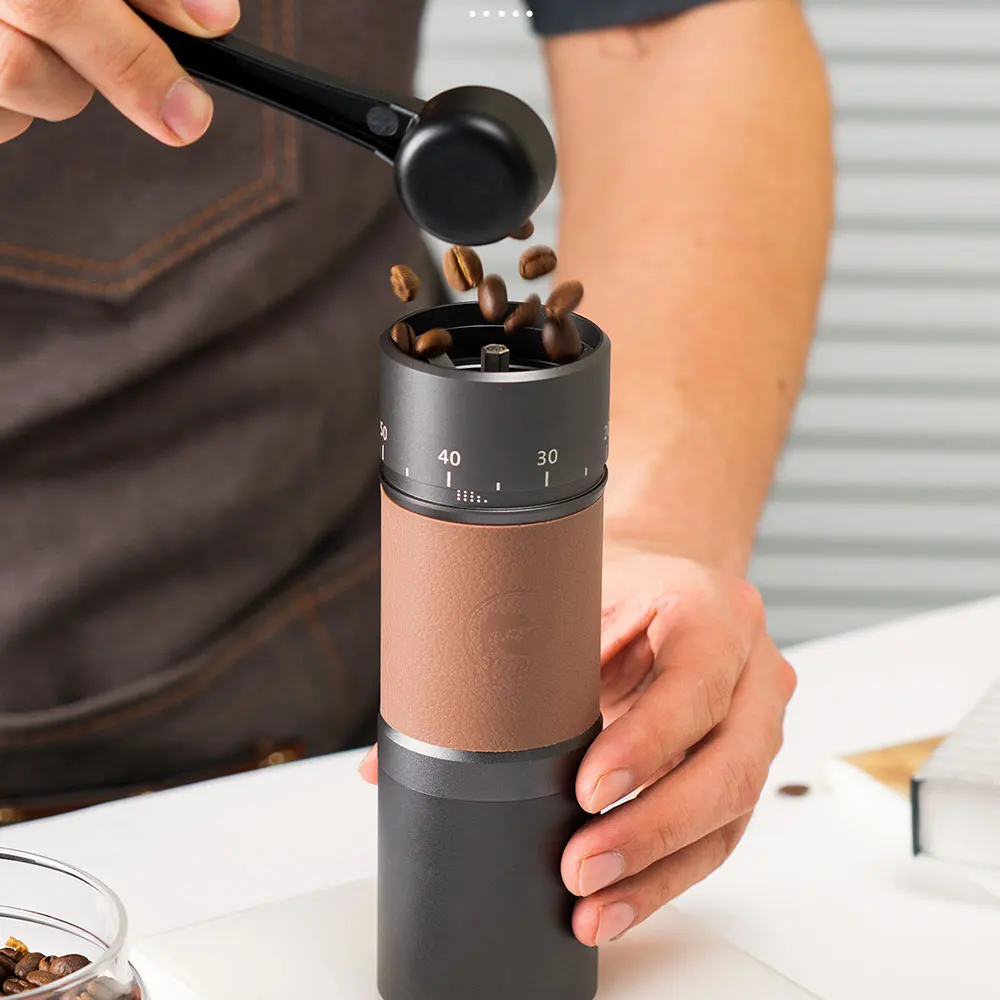
One of the most immediately noticeable benefits of larger burrs is grinding speed. With each rotation, large burrs process significantly more coffee than smaller ones:
- A 38mm burr set might grind 1-1.5g of coffee per second
- A 64mm burr set can process 2-3g per second
- Commercial 83mm+ burrs can exceed 5g per second
This speed advantage comes from simple geometry—the grinding surface area increases exponentially with diameter. For home brewers, this means less time waiting for your morning coffee. A typical dose for pour-over (20g) might take 25-30 seconds with larger burrs instead of a full minute with smaller ones.
Precision manual grinders with larger burrs require fewer turns to complete the same grinding task, reducing user fatigue and making the brewing process more enjoyable.
The efficiency advantage extends beyond mere convenience. Faster grinding means:
- Less heat buildup in the coffee (as discussed in the previous section)
- Less oxidation exposure during the grinding process
- More consistent results between the first and last portions of ground coffee
For home users who grind daily, the time savings add up quickly. Over a year, the difference between a 38mm and 64mm burr set could save hours of cumulative grinding time while delivering more consistent results.
Beyond Size: Crucial Factors Working Alongside Burr Dimensions
While burr size is important, several other factors work alongside size to determine overall grind quality:
Burr Geometry and Design
The pattern, shape, and arrangement of cutting teeth significantly impact grind quality:
- Flat burrs consist of two parallel rings with cutting teeth, known for consistency
- Conical burrs have a cone-shaped center burr that fits inside a ring-shaped outer burr
- Tooth pattern determines how beans are broken down as they move through the grinding path
- Cutting angles affect cleanness of cut versus crushing force applied to beans
A well-designed smaller burr set can outperform a poorly designed larger one. The critical impact of burr alignment on coffee cannot be overstated—even giant premium burrs will perform poorly if they’re misaligned.
Material Quality
Burr material significantly impacts performance and longevity:
- Standard steel burrs are common in entry-level grinders
- Hardened steel with specialized coatings offers better durability and edge retention
- Ceramic burrs generate less heat but may be more brittle
Premium burr sets are often made from specially hardened steel alloys with precise machining tolerances. These materials maintain their sharp edges longer and resist wear, ensuring consistent performance over thousands of pounds of coffee.
Motor and Drive System
The motor and drive system must be appropriate for the burr size:
- Larger burrs require more torque but can operate at lower RPMs
- Direct-drive systems often provide more stable grinding than geared systems
- Motor quality affects speed stability under load, which impacts grind consistency
As burr size increases, the motor and drive system become even more critical—insufficient power can cause speed fluctuations that hurt grind consistency, especially with dense, light-roasted beans.
Flat vs. Conical Burrs: How Size Impacts Different Designs
Flat and conical burrs have fundamental differences in how they grind coffee, and size affects each design differently:
| Feature | Flat Burrs | Conical Burrs |
|---|---|---|
| Structure | Two parallel discs | Cone inside a ring |
| Size Impact | Direct increase in surface area | Increased outer circumference |
| Particle Shape | More uniform, fewer fines | Slightly wider distribution |
| Heat Generation | Generally higher | Generally lower |
| Typical Flavor Profile | Clarity, brightness | Body, complexity |
With flat burrs, size increases directly correlate to grinding surface area. As the diameter grows, the entire surface participates in grinding. Our selection of manual coffee burr grinders includes both designs to accommodate different preferences.
For conical burrs, increasing the size primarily enlarges the outer circumference where beans initially break down. The inner portions of conical burrs do the fine grinding work, and their geometry changes more gradually with size increases.
Espresso enthusiasts often prefer larger flat burrs for their ability to produce extremely uniform particles, which helps prevent channeling (water finding the path of least resistance through the puck). Pour-over brewers might appreciate the slight bimodal distribution from conical burrs, which can add complexity to the cup.
Practical Implications: What Burr Size Means for Your Coffee
Different brewing methods place different demands on your grinder, affecting how much burr size matters:
For Espresso
Espresso requires exceptional precision and consistency:
– Recommended minimum: 50mm burrs (home use), 60mm+ (prosumer)
– Benefits from larger burrs’ ability to produce consistent fine grinds
– Needs minimal fines to prevent channeling and bitter extraction
– Requires precise adjustability between grind settings
Understanding espresso grind settings for the perfect shot is crucial, and larger burrs often provide the fine adjustment capability needed for dialing in espresso.
For Pour-Over/Filter
Pour-over brewing benefits from:
– Recommended minimum: 40mm burrs
– Uniform medium grinds with minimal fines
– Clean cup clarity that comes from consistent extraction
– Even particle size that allows proper drawdown time
For French Press/Immersion
Coarser brewing methods like French press need:
– Recommended minimum: 38mm burrs
– Consistent coarse grounds without excessive fines
– Minimal fines to reduce sediment in the cup
– Even extraction across the longer brew time
Manual espresso grinders with larger burrs excel at providing the consistency and adjustment precision needed for espresso, while still being versatile enough for other brewing methods.
The Law of Diminishing Returns: When Bigger Isn’t Better
While larger burrs offer advantages, they come with trade-offs that follow the law of diminishing returns:
Cost Increases:
– Entry-level 38mm burr grinders: $100-200
– Mid-range 50-55mm burr grinders: $200-350
– Premium 64mm burr grinders: $400-700
– Commercial 83mm+ burr grinders: $1,000+
The price jump between size categories is substantial, often doubling or tripling the cost for relatively modest increases in performance.
Size and Weight Considerations:
– Larger burrs require bigger housings
– Heavier grinders need more counter space
– Manual grinders become more challenging to operate by hand
Performance Gains:
– 38mm to 50mm: Noticeable improvement in consistency and speed
– 50mm to 64mm: Moderate improvement, especially for espresso
– 64mm to 83mm+: Subtle improvements that casual drinkers may not detect
For most home brewers, the sweet spot often lies in the 50-64mm range, where performance is excellent without reaching the extreme costs of commercial-grade equipment. Beyond this point, other grinder features may deliver more value than further increases in burr size.
Myth vs. Reality: Common Misconceptions About Burr Size
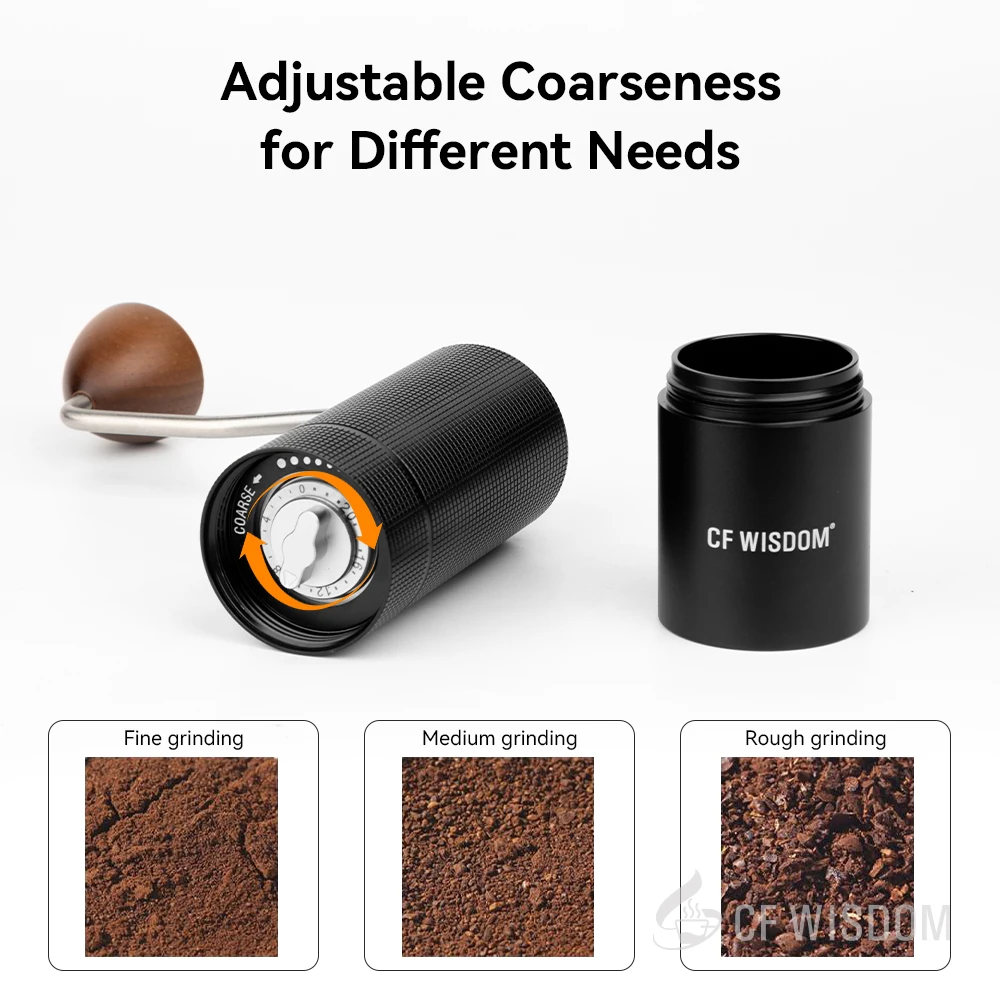
Several myths about burr size persist in coffee communities:
Myth: “Larger burrs are always better regardless of other factors.”
Reality: A well-designed, properly aligned 50mm burr set can outperform a poorly manufactured 65mm set. Quality of manufacturing and precision of alignment often matter more than raw size.
Myth: “Small burrs can’t produce excellent coffee.”
Reality: Many specialty coffee competitions have been won using coffee ground on grinders with moderate-sized burrs. Technique and bean quality remain paramount.
Myth: “Burr size is the most important specification to consider.”
Reality: Burr material, design, alignment precision, and motor quality all work together with size to determine overall performance. A holistic approach to grinder evaluation is essential.
Myth: “You need commercial-sized burrs for good espresso at home.”
Reality: While larger burrs help with espresso grinding, many home baristas achieve excellent results with 50-55mm burrs when paired with good technique and proper alignment.
The reality is that burr size is just one factor in a complex system. A balanced perspective recognizes the advantages of larger burrs while acknowledging that size alone doesn’t guarantee superior results.
Choosing the Right Burr Grinder: Practical Recommendations
When selecting a coffee grinder, consider these factors alongside burr size:
For Primarily Espresso Brewing:
– Prioritize burr size (50mm minimum recommended)
– Look for fine adjustment capability
– Consider stepless adjustment mechanisms
– Evaluate alignment precision and stability
For Filter Coffee Focus:
– 40mm+ burrs typically provide sufficient consistency
– Prioritize even particle distribution over absolute size
– Consider ease of use and cleaning
For All-Around Use:
– 50mm+ burrs offer good versatility
– Look for wide adjustment range
– Consider how easily you can switch between brew methods
Budget Considerations:
– Under $200: Expect 38-45mm burrs with good but not exceptional performance
– $200-400: 50-55mm burrs with significantly improved consistency
– $400+: 60mm+ burrs with premium features and materials
Our selection of hand burr grinders offers options across these categories, all designed to deliver consistent grounds while being easier to use than traditional manual grinders.
Remember that grinder quality is often the most impactful investment you can make in your coffee setup—more so than brewing equipment. It’s generally better to invest in a quality grinder with moderately-sized burrs than a larger but inferior design.
How to Evaluate Grind Quality Regardless of Burr Size
Rather than focusing solely on burr specifications, learn to evaluate the actual results:
Visual Inspection:
1. Grind a small amount of coffee onto a dark surface
2. Spread the grounds thinly with a card
3. Look for consistency in particle size
4. Check for excessive dust (fines) or obvious large chunks (boulders)
Sifting Test:
1. Use a fine mesh strainer or sieve
2. Gently shake grounds through the mesh
3. Measure the percentage that passes through (fines)
4. Lower percentages of fines generally indicate better consistency
Extraction Evaluation:
1. For espresso, look for even flow without channeling
2. For pour-over, check for even drawdown without stalling
3. Taste for balance—neither sour (under-extraction) nor bitter (over-extraction)
4. Assess clarity and distinguishable flavor notes
These practical tests often reveal more about grinder performance than specifications alone. A grinder producing visibly consistent grounds that extract well is succeeding at its fundamental purpose, regardless of burr size.
Maintaining Your Burr Grinder for Optimal Performance
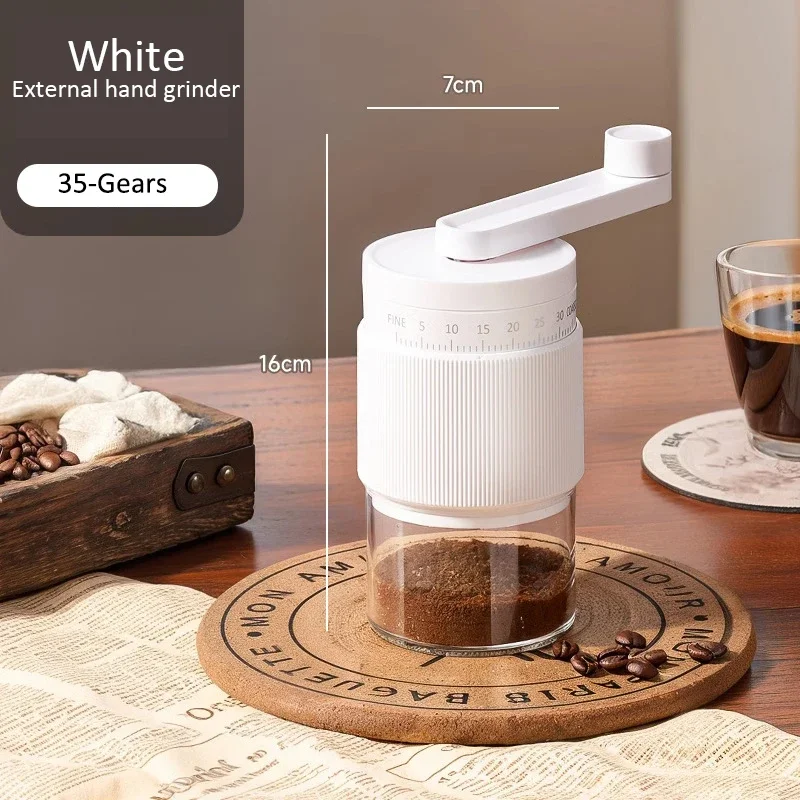
Proper maintenance can maximize performance with any burr size:
Regular Cleaning:
– Clean burrs every 1-2 weeks for daily users
– Remove old coffee oils that can go rancid
– Clear any buildup from adjustment mechanisms
– Use a soft brush and specialized grinder cleaning tablets
Alignment Checks:
– Periodically check for signs of uneven wear
– Listen for unusual sounds that might indicate misalignment
– For precision grinders, consider alignment tools for optimal setup
Burr Replacement:
– Steel burrs typically last 500-1500 pounds of coffee
– Ceramic burrs may last longer but are more fragile
– Replace burrs when visible dulling occurs or consistency decreases
Understanding whether coffee grinders need maintenance is essential for long-term performance. Even the largest, highest-quality burrs will underperform when dull or misaligned. Regular maintenance ensures your grinder continues to perform at its best.
Fine Adjustment Hand Grinder, Precision Manual Grinder, Travel Coffee Grinder
Price range: $185.11 through $494.63 Select options This product has multiple variants. The options may be chosen on the product pageHand Burr Grinder, Hand Crank Coffee Grinder, Manual Espresso Grinder, Portable Coffee Grinder
Price range: $262.72 through $300.22 Select options This product has multiple variants. The options may be chosen on the product pageManual Burr Mill, Manual Coffee Grinder Stainless Steel, Manual Coffee Mill Grinder, Mechanical Coffee Grinder
Price range: $127.26 through $130.32 Select options This product has multiple variants. The options may be chosen on the product pageHand Burr Grinder, Manual Coffee Grinder Stainless Steel, Precision Manual Grinder
Price range: $183.64 through $187.52 Select options This product has multiple variants. The options may be chosen on the product page
Future Innovations: Where Burr Design Is Heading
The coffee grinder industry continues to evolve beyond simply increasing burr size:
Advanced Materials:
– New coating technologies to improve hardness and reduce friction
– Novel alloys that maintain sharpness longer
– Composite materials combining different properties
Geometric Innovations:
– Computer-optimized cutting patterns for specific brewing methods
– Variable pitch designs that change throughout the grinding path
– Hybrid approaches combining benefits of flat and conical designs
Manufacturing Precision:
– Improved machining techniques reducing tolerances to microns
– Better alignment systems to maintain performance over time
– More consistent quality control across production batches
These innovations suggest that future improvements in grind quality may come from refinements in design and materials rather than simply increasing size. For coffee enthusiasts, this means more specialized tools matched precisely to specific brewing needs.
The Ultimate Question: Does Size Really Matter?
So, does burr size affect coffee grind quality? Yes, it does—but with important nuances:
Larger burrs generally offer advantages in consistency, heat management, and speed. These benefits can translate to more evenly extracted coffee with clearer flavor definition. For precision-demanding methods like espresso, these advantages can be particularly noticeable.
However, burr size is just one component in a complex system. Material quality, design geometry, manufacturing precision, alignment, and motor performance all work together to determine actual grinding performance. A moderately-sized burr set with excellent design and precision can outperform larger burrs of lesser quality.
For most home coffee enthusiasts, the ideal approach is balanced: recognize the benefits of larger burrs while considering your specific brewing methods, budget, and space constraints. A quality 50-55mm grinder will serve most home users exceptionally well, while those focusing exclusively on espresso might benefit from larger burrs if budget allows.
Ultimately, the grinder that helps you consistently produce delicious coffee—regardless of specifications—is the right one for you.

